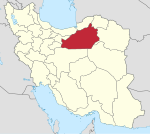|
Sheikh Bastami Mosque
Sheikh Bastami Mosque is a 14th-century religious complex located in downtown Semnan Province, Bastam. It is named after Abu Yazid al-Bastami, better known as Bayazid Bastami, who is buried in that place alongside Muhammad ibn Ja'far al-Sadiq. The complex comprises a mosque, madrasah and the tombs of the aforementioned personalities.[3] HistoryConstruction on the shrine of Bayazid Bastami is theorised to have predated the Seljuk era,[4] but the oldest inscription extant on the building gives the date of construction as being in the year 1120.[5] During the reign of the Ilkhanid ruler Mahmud Ghazan, the religious complex underwent restoration in 1299.[6] After his death, his successor Öljeitü added an eastern entrance portal and a corridor, as well as an iwan across the courtyard of the mosque. Later on, the Timurid ruler Shah Rukh attached a madrasah to the religious complex.[7] ArchitectureThe main iwan leading into the religious complex is formed of a tall arch with a semi-dome of muqarnas, the walls covered with faience and unglazed terracotta.[8] The mosque building is decorated with carved stucco, which dates back to the restoration under Mahmud Ghazan.[9] Several design elements of the mosque building is Seljuk, such as the minaret and one of the walls. The minaret is 20 metres tall.[10] This mosque also has two shabestan, the larger one is used for men and the smaller one is used for women.[11] The tomb of Bayazid Bastami is located directly next to one of the walls of the complex, in the courtyard. It is a simple structure and is not lavish at all, possibly to reflect the piety and asceticsm of the entombed saint.[12] The tomb of Muhammad ibn Ja'far al-Sadiq is located on the southern side of the religious complex. It has a conical dome over it, and the tomb is located under the dome. The tomb is sometimes known as an Imamzadeh.[13] See alsoReferences
Wikimedia Commons has media related to Sheikh Bastami Mosque.
|
||||||||||||||||||||||||||||||||

